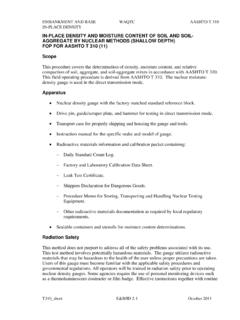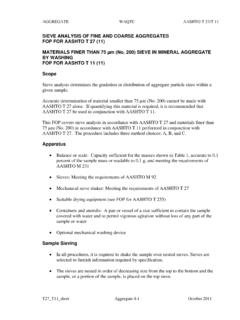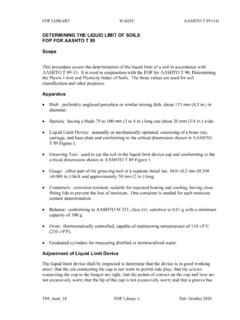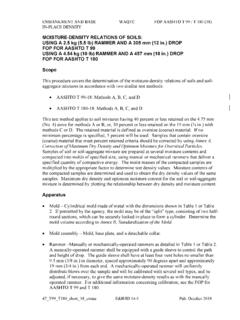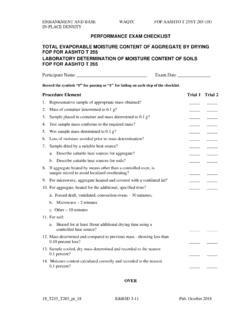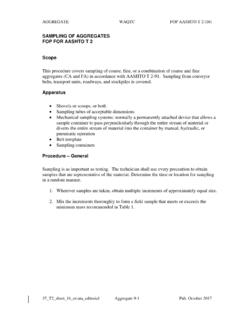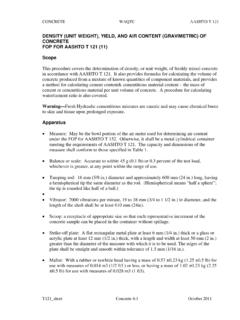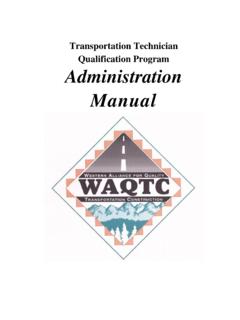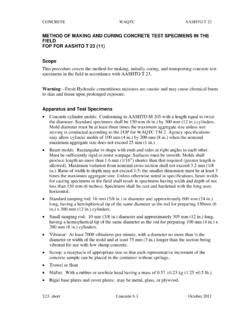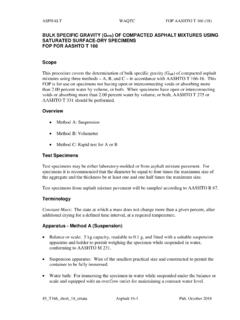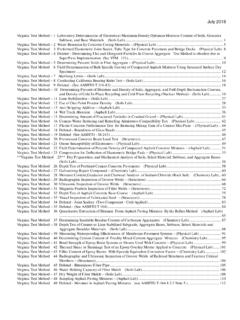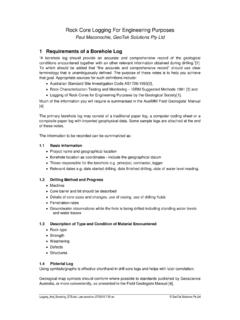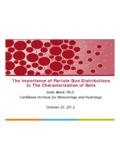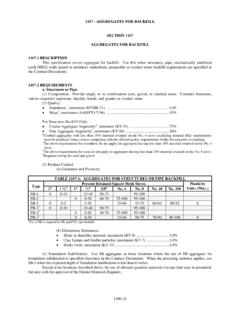Transcription of CORRECTION FOR COARSE PARTICLES IN THE SOIL …
1 EMBANKMENT AND BASE WAQTC AASHTO T 224 IN-PLACE DENSITY T224_short E&B/ID 5-1 October 2011 CORRECTION FOR COARSE PARTICLES IN THE soil compaction TEST FOP FOR AASHTO T 224 (11) Scope This procedure covers the adjustment of the maximum dry density determined by FOP for AASHTO T 99 / T 180 to compensate for COARSE PARTICLES retained on the mm (No. 4) or mm (3/4 in.) sieve. For Methods A and B of the FOP for AASHTO T 99 / T 180 the adjustment is based on the percent, by mass, of material retained on the mm (No. 4) sieve and the bulk specific gravity (Gsb) of the material retained on the mm (No. 4) sieve. A maximum of 40% of the material can be retained on the mm (No. 4) sieve for this method to be used. For Methods C and D of the FOP for AASHTO T 99 / T 180, the adjustment is based on the percent, by mass, of material retained on the mm (3/4 in.) sieve and the bulk specific gravity (Gsb) of the material retained on the mm (3/4 in.)
2 Sieve. A maximum of 30% of the material can be retained on the mm (3/4 in.) sieve for this method to be used. Whether the split is on the mm (No. 4) or the mm (3/4 in.) sieve, all material retained on that sieve is defined as oversized material. This method applies to soils with percentages up to the maximums listed above for oversize PARTICLES . A CORRECTION may not be practical for soils with only a small percentage of oversize material. The agency shall specify a minimum percentage below which the method is not needed. If not specified, this method applies when more than 5 percent by weight of oversize PARTICLES is present. Adjustment Equation Moisture Along with density, the moisture content can be corrected. The moisture content can be determined by the FOP for AASHTO T 255 / T 265, other agency approved methods, or the nuclear density gauge moisture content reading from the FOP for AASHTO T 310. If the nuclear gauge moisture reading is used, or when the moisture content is determined on the entire sample (both fine and oversized PARTICLES ), the use of the adjustment equation is not needed.
3 Combined moisture contents with material having an appreciable amount of silt or clay should be performed using FOP for AASHTO T 255 / T 265 ( soil ). Moisture contents used from FOP for AASHTO T 310 must meet the criteria for that method. When samples are split for moisture content (oversized and fine materials) the following adjustment equations must be followed: 1. Split the sample into oversized material and fine material. 2. Dry the oversized material following the FOP for AASHTO T 255 / T 265 (Aggregate). If the fine material is sandy in nature, dry using the FOP for AASHTO T 255 / T 265 (Aggregate), or other agency approved methods. If the fine material has any appreciable amount of clay, dry using the FOP for AASHTO T 255 / T 265 ( soil ) or other agency approved methods. 3. Calculate the dry mass of the oversize and fine material as follows: 1 MC EMBANKMENT AND BASE WAQTC AASHTO T 224 IN-PLACE DENSITY T224_short E&B/ID 5-2 October 2011 Where: MD = mass of dry material (fine or oversize PARTICLES ).
4 Mm = mass of moist material (fine or oversize PARTICLES ). MC = moisture content of respective fine or oversized, expressed as a decimal. 4. Calculate the percentage of the fine and oversized PARTICLES by dry weight of the total sample as follows: See Note 2. 100 73% 100 73% And 100 27% 100 27% Or for Pc: Pc = 100 - Pf Where: Pf = percent of fine PARTICLES , of sieve used, by weight. Pc = percent of oversize PARTICLES , of sieve used, by weight. MDF = mass of fine PARTICLES . MDC = mass of oversize PARTICLES . 5. Calculate the corrected moisture content as follows: 100 MCT = corrected moisture content of combined fines and oversized PARTICLES , expressed as a % moisture. MCF = moisture content of fine PARTICLES , as a % moisture.
5 MCC = moisture content of oversized PARTICLES , as a % moisture. Note 1: Moisture content of oversize material can be assumed to be two (2) percent for most construction applications. Note 2: In some field applications agencies will allow the percentages of oversize and fine materials to be determined with the materials in the wet state. EMBANKMENT AND BASE WAQTC AASHTO T 224 IN-PLACE DENSITY T224_short E&B/ID 5-3 October 2011 Adjustment Equation Density 6. Calculate the corrected dry density of the total sample (combined fine and oversized PARTICLES ) as follows: 100 100 Where: Dd = corrected total dry density (combined fine and oversized PARTICLES ) kg/m3 (lb/ft 3). Df = dry density of the fine PARTICLES kg/m3 (lb/ft3), determined in the lab. Pc= percent of oversize PARTICLES , of sieve used, by weight.
6 Pf = percent of fine PARTICLES , of sieve used, by weight. k = Metric: 1,000 * Bulk Specific Gravity (Gsb) (oven dry basis) of COARSE PARTICLES (kg/m3). k = English: * Bulk Specific Gravity (Gsb) (oven dry basis) of COARSE PARTICLES (lb/ft3). Note 3: If the specific gravity is known, then this value will be used in the calculation. For most construction activities the specific gravity for aggregate may be assumed to be Calculation Sample Calculations: Metric: Maximum laboratory dry density (Df): 2329 kg/m3 Percent COARSE PARTICLES (Pc): 27% Percent fine PARTICLES (Pf): 73% Mass per volume COARSE PARTICLES (k): ( ) (1000) = 2697 kg/m3 EMBANKMENT AND BASE WAQTC AASHTO T 224 IN-PLACE DENSITY T224_short E&B/ID 5-4 October 2011 100 2329 2697 2329 27% 2697 73% 10073% 2329 27% 2697 628,131,300 628,883 2697 2418 2418 English: Maximum laboratory dry density (Df): lb/ft3 Percent COARSE PARTICLES (Pc): 27% Percent fine PARTICLES (Pf): 73% Mass per volume of COARSE PARTICLES (k).
7 ( ) ( ) = lb/ft3 100 27% 73% 10073% 27% 2,362,932 100 2,362,932 16, 100 Report Results shall be reported on standard forms approved by the agency. Report adjusted maximum dry density to the closest 1 kg/m3 ( lb/ft3).
